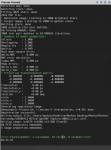markuspaul
Active member
Hello.
I have taken a set of M27 images with an 11" inch telescope (2800mm length) consistently get error messages when I try to use the star alignment process. When I use the same process on a set of images taken with a 400mm Nikon lense it works just fine. The 27 images were done at high gain with lots of noise and the stars are rather large. I have tried to play around with the parameters (RANSAC tolerance etc.) but consistently had errors.
The images are posted in the below directory with the reference file named as such. If someone is able to tell me either how I can change the parameter to get PI to align the images or if there is something fundamentally wrong with the images I would be very grateful.

I have taken a set of M27 images with an 11" inch telescope (2800mm length) consistently get error messages when I try to use the star alignment process. When I use the same process on a set of images taken with a 400mm Nikon lense it works just fine. The 27 images were done at high gain with lots of noise and the stars are rather large. I have tried to play around with the parameters (RANSAC tolerance etc.) but consistently had errors.
The images are posted in the below directory with the reference file named as such. If someone is able to tell me either how I can change the parameter to get PI to align the images or if there is something fundamentally wrong with the images I would be very grateful.


